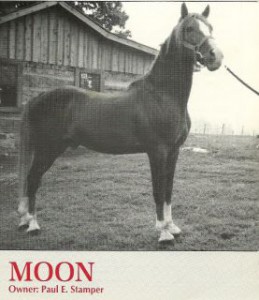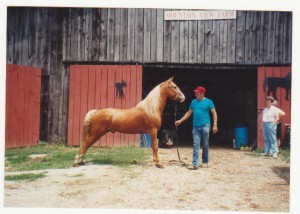|
A particular type of horse was being bred on the steep hillsides of Eastern Kentucky, to work the fields and “ride the best”. The following evidence indicates that this horse, better known as the Mountain Pleasure Horse, influenced the other gaited breeds from the begining, but were never credited as such.Genetic testing has since proven them to be ancestors to several modern breeds including the American Saddlebred and the Tennessee Walking Horse. Historians recount how early breeders made trips to Kentucky to seek out the finest gaited mares. Horsemen knew that if you wanted to produce a horse with a distinct four-beat lateral gait, you would need to breed to the “saddle mares” from the hills of Kentucky. Few formal breeding records were ever kept, but the Mountain Pleasure Horse bloodlines can be traced back for over 160 years.

The Dates
“We’ben breeding and using the Mountain Pleasure Horse in my family clear back to Grandpa J. C. Stamper. I’m guessing now, but I believe he was born about 1815, “says Marion Stamper, himself 81, born in 1903, the son of Tom Stamper – born 1881, and grandson of Lewis Green Stamper – born 1848. (Marion was mistaken – the date on the tombstone in the Stamper Family Cemetery shows J. C. Stamper to be born in 1812). He wasn’t wrong about himself, his Daddy, his Daddy before him, and his Daddy before him breeding and trading the Mountain Pleasure Horse.
“We just called him the Mountain Horse back then. That “Pleasure” part is new. We didn’t have much time for “pleasure” – except maybe on Sundays” he remarks. “Horses up here had to work for a living- they still do for that matter. No one could afford a horse that only rode good, but wouldn’t work. People up here had families to feed. There weren’t stores in those days. You ate what you grew. We all had big families that had to eat come winter. I learned what I know from my Daddy, and he got it from his Daddy. We’ve always been in the horse tradin’ business and farming too, of course. That’s all we ever knew to do”.
Marion then stated that the family land in Stamper Branch (an area near Hazel Green, in Wolfe County, KY) has been in the family “ever since Homestead. Never has been sold.”
From Alfred Prewitt, a resident of Mt. Sterling, KY (Montgomery County) and Fayetteville, N.C.: “My family has been raising these horses since way before the Civil War. Showing a photo of Vergeland, as it looked back in 1841 when the barn was completed. It was a two story barn. The carriage house was at ground level, and the stabling area was underground, carved out of the limestone.”
“There’s a family story about a great great grandmother of ours Anne Kenney. They say she saw a horseman trotting real fast up the road towards her. “Where are you going in such a hurry, she asked the rider. “Mr. Lincoln’s dead. Mr. Lincoln’s dead.” They say she said, “Well, you will be down to the barn and get yourself a good one. Just leave yours there.” A month later he brought the horse back and asked to buy it.
Great great grandfather, Caswell Prewitt, built that house for his 12 children, and the barn for his Mountain Horses. The barn was completed in 1841,” concluded Al Prewitt. “He had his horses even earlier than that, and we have had them ever since, too. I know that they’re my family’s “Living History.”

Paul Stamper and Goble
How the Blood Stayed True
The terrain of Eastern Kentucky is mountainous – Appalachian style. Coal mining is still a major industry in these parts. Between the steep hills run crevices or “hollows”, usually containing a running creek or small river. In these hollows (sometimes called creeks or branches), the early Kentucky settlers made their homes, hunting and farming up the steep hillsides. Harsh and inaccessible, the terrain provided the early Kentuckians the privacy they sought.
“The original settlers of these hills came here from the other colonies. This was frontier country in those days. They were independent kind of folks. They had their own ideas, and they kept to themselves. They didn’t like to fool much with people,” says Dr. Gordon Layton, a well known equine veterinarian, of Paris, Kentucky, and one of the founders of the Mountain Pleasure Horse Association.
“They could do just a bout anything. They made what they needed. If they couldn’t make it, they did without it. Some people might call them backward in some ways, but they still don’t need civilization to be productive. They made these harsh mountains and climate provide for them and their families, and they wouldn’t have it any other way. Modern conveniences are nice to have, and they do have them. The important thing to remember about the mountain people is that they don’t NEED them”.
You might not want to live that way, but you have to respect it”, Layton adds.
“Only a few people ever bothered keeping track of the bloodlines since it was really a “community” thing. Someone along the creek had a good stallion – the kind whose colts worked good and rode the best. Mare owners along the creek bred to him. Everyone mostly stayed around their own branch.” says Paul Stamper, son of Marion.
Because the Eastern Kentucky horsemen lived pretty well within their “hollows’ and creek, many horses had the same name, i.e. “Rex”, “Buck”, “Star”, “Major”, “Silver”, and “Ginger”. They became known outside their hollows by the family name that owned them: “Brewer’s Pearl”. “Chaney’s Palomino Mare”, “Oldfield’s Silver Mare”, “Little’s Silver”, “Cable’s Rex”, “Coffey’s Major” even a “Stamper stallion” (often palomino for that was local/family specialty) and “Ebb Montgomery stock”.
Further confusing the issue, it seems “Oldfield’s Silver”, was in fact by Little’s Silver. Horses were often named for their color, such as “Copper” and “Ginger”. Sometimes they weren’t named at all, just identified by the mountain horsemen as “Cable’s Good Yellow Mare”. These horsemen knew, of course, which mare they meant and that she was different from Cable’s other good yellow mares.
The most unique name of all was “Big’un Goodpasture’s Horse”. This particular horse, a black, is said to be the Black Squirrel line that was so much a part of the beginnings of the American Saddlebred registry.
Walk these hills, or lock in your 4wheel hubs and drive these hills and talk to these folks. Everyone has glowing tales of getting a wonderful colt, or knowing of a wonderful colt sired by “The Goodpasture Horse”, or “Big Good” as they’ll also refer to him.
Tracing these bloodlines would be completely impossible for an outsider, but to these mountain horsemen, however, they are as clearly distinct as if they each had their own color. Listening as they proudly talk of the almost unbelievable feats these animals performed with regularity, and which, by survival needs, were a requirement, You’ll hear certain names repeated “Rex, “Buck”, but without a guide, you’ll never know that the horse being discussed is Jasper Jones’ Bucky, or Cable’s Rex, for there are countless d Rex and Bucky horses totally unrelated. |

